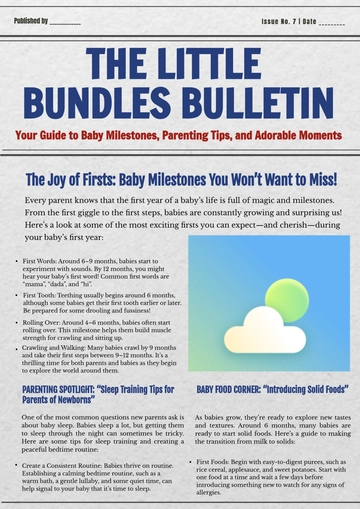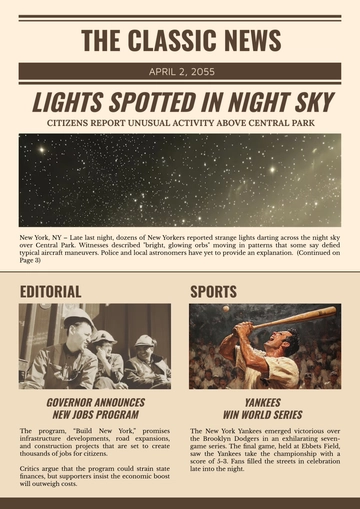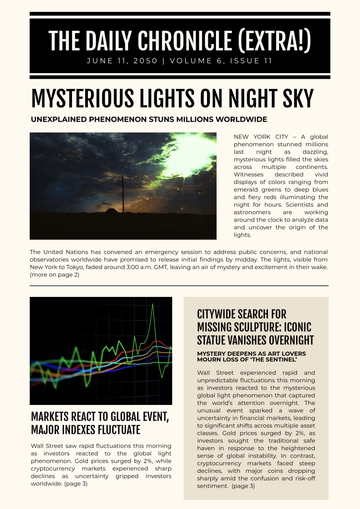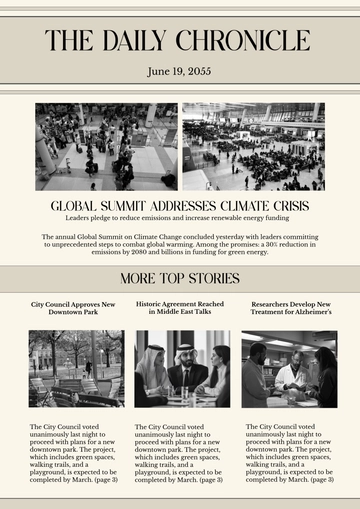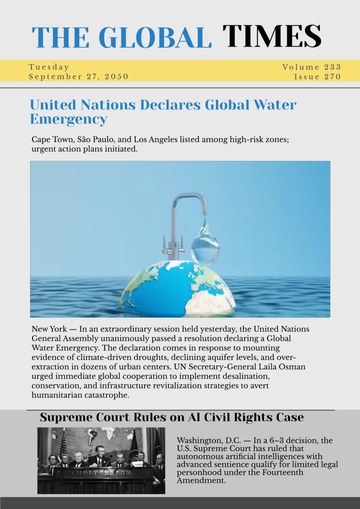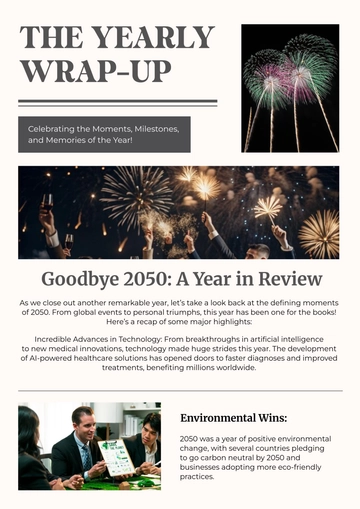Free SEO-Optimized Newspaper Article

Prepared by: [Your Name]
Date: [Date]
1. Introduction
Renewable energy is rapidly becoming the cornerstone of global energy strategies as nations work to combat climate change and reduce their dependence on fossil fuels. This SEO-optimized newspaper article delves into the current state of renewable energy, exploring its potential, challenges, and future outlook. We will cover various types of renewable energy, government policies, technological advancements, and market trends, providing a detailed and professional overview of the subject.
2. The Rise of Renewable Energy
2.1. Global Energy Demand and Environmental Concerns
The world's energy demand is on a steep incline, driven by population growth and industrialization. However, this growth has brought significant environmental concerns, particularly due to the heavy reliance on fossil fuels, which contribute to greenhouse gas emissions and global warming.
Population Growth: The global population is expected to reach 9.7 billion by 2050, increasing energy consumption.
Industrialization: Emerging economies are rapidly industrializing, further driving the energy demand.
Environmental Impact: Burning fossil fuels is the largest source of CO2 emissions, exacerbating climate change.
2.2. Types of Renewable Energy
Renewable energy comes in various forms, each with its advantages and challenges. Here is a detailed look at the most prominent types:
A. Solar Energy
Solar energy harnesses the power of the sun through photovoltaic (PV) cells and solar thermal systems. It is one of the most widely used renewable energy sources.
Advantages: Abundant, low operating costs, scalable.
Challenges: High initial investment, weather-dependent, requires large land areas.
B. Wind Energy
Wind energy captures the kinetic energy of wind through turbines, converting it into electricity. It is a rapidly growing segment in the renewable energy market.
Advantages: Cost-effective, abundant in windy regions, low operating costs.
Challenges: Visual and noise impact, intermittency, impact on wildlife.
C. Hydropower
Hydropower utilizes the energy of flowing water to generate electricity. It is one of the oldest and most established renewable energy sources.
Advantages: Reliable, large-scale power generation, long lifespan.
Challenges: Environmental impact on aquatic ecosystems, displacement of communities, high initial costs.
D. Biomass Energy
Biomass energy is derived from organic materials, such as wood, agricultural residues, and animal waste. It is a versatile source of energy, used for heating, electricity, and transportation fuels.
Advantages: Reduces waste, is carbon-neutral, and can be produced locally.
Challenges: Requires large amounts of feedstock, potential competition with food production, and emissions from combustion.
E. Geothermal Energy
Geothermal energy taps into the heat stored beneath the Earth's surface to generate electricity and provide heating.
Advantages: Constant energy supply, small land footprint, low emissions.
Challenges: Limited to specific locations, high drilling costs, and potential for induced seismic activity.
3. Government Policies and Incentives
3.1. Global Renewable Energy Policies
Governments worldwide are implementing policies to promote the adoption of renewable energy. These policies are crucial in driving the transition from fossil fuels to cleaner energy sources.
Subsidies and Tax Incentives: Many countries offer financial incentives for renewable energy projects, including grants, tax credits, and rebates.
Renewable Portfolio Standards (RPS): Some regions mandate that a certain percentage of electricity must come from renewable sources.
Feed-in Tariffs: These guarantee a fixed price for renewable energy producers, encouraging investment in the sector.
Carbon Pricing: By putting a price on carbon emissions, governments incentivize the reduction of fossil fuel use and the adoption of cleaner alternatives.
3.2. Case Studies of Successful Policies
Germany’s Energiewende: Germany’s ambitious energy transition policy, known as Energiewende, aims to achieve a low-carbon, nuclear-free energy system by 2050. The country has seen significant growth in renewable energy, particularly in solar and wind power.
China’s Renewable Energy Law: China’s Renewable Energy Law, enacted in 2050, has spurred massive investments in renewable energy, making the country the largest producer of wind and solar power globally.
4. Technological Advancements in Renewable Energy
4.1. Innovations in Solar Power
Solar power technology has seen remarkable advancements in recent years, making it more efficient and accessible.
A. High-Efficiency Solar Panels
The development of high-efficiency solar panels, such as those using monocrystalline silicon or tandem cells, has increased energy conversion rates, allowing for more power generation from the same amount of sunlight.
B. Solar Energy Storage
Energy storage solutions, particularly batteries, are crucial for overcoming the intermittency of solar power. Innovations in lithium-ion batteries and emerging technologies like solid-state batteries are enhancing the storage capabilities, making solar energy more reliable.
4.2. Wind Energy Technology
Wind energy technology is also developing, with improvements in turbine design and materials, leading to greater efficiency and lower costs.
A. Offshore Wind Farms
Offshore wind farms, located in ocean waters, harness stronger and more consistent winds than onshore installations. Advances in turbine size and floating platforms are making offshore wind a viable and competitive energy source.
B. Smart Wind Turbines
Smart wind turbines equipped with sensors and AI-driven analytics can optimize performance by adjusting blade angles and predicting maintenance needs, reducing downtime and increasing energy output.
5. Market Trends and Economic Impact
5.1. Growth of the Renewable Energy Market
The renewable energy market is experiencing rapid growth, driven by declining costs, technological advancements, and supportive government policies.
A. Market Size and Projections
2050 Market Size: $1.1 trillion (global renewable energy market).
2055 Projection: Expected to reach $2.2 trillion, with a CAGR of 10.4%.
B. Leading Companies in Renewable Energy
Company Name | Headquarters | Specialization | Market Share (%) |
|---|---|---|---|
NextEra Energy | United States | Solar, Wind | 15 |
Vestas Wind Systems | Denmark | Wind Turbines | 12 |
Siemens Gamesa | Spain | Wind Turbines | 10 |
Orsted | Denmark | Offshore Wind | 8 |
First Solar | United States | Solar Panels | 7 |
5.2. Economic Impact of Renewable Energy
The shift to renewable energy has significant economic implications, including job creation, investment opportunities, and changes in energy prices.
Job Creation: The renewable energy sector employed over 12 million people globally in 2050, with solar and wind energy being the largest employers.
Investment Opportunities: With the growing demand for clean energy, investment in renewable energy projects is attracting significant capital from both public and private sectors.
Energy Prices: The cost of renewable energy has been steadily decreasing, with solar and wind power now being some of the cheapest sources of electricity.
6. Challenges and Solutions in Renewable Energy Adoption
6.1. Intermittency and Reliability
One of the major challenges of renewable energy is its intermittency, as sources like solar and wind are not always available.
Solutions
Energy Storage Systems: Advanced batteries and other storage solutions can store excess energy for use during periods of low generation.
Grid Modernization: Upgrading the electricity grid to accommodate variable energy sources and integrating smart technologies can improve reliability.
6.2. Environmental and Social Impacts
While renewable energy is cleaner than fossil fuels, it still has environmental and social impacts that need to be addressed.
Solutions
Sustainable Siting: A careful selection of locations for renewable energy projects can minimize environmental effects, such as habitat destruction and water usage.
Community Engagement: Involving local communities in the planning and decision-making process can help address social concerns and ensure equitable benefits.
7. Conclusion
The future of renewable energy is promising, with ongoing advancements in technology, supportive government policies, and growing market demand driving the transition to a cleaner, more sustainable energy system. However, challenges remain, and continued innovation and collaboration are essential to fully realize the potential of renewable energy.
Renewable energy is not just a solution to the environmental challenges of today, but also a pathway to economic growth and energy security for the future. As the world continues to embrace renewable energy, the collective effort to overcome obstacles and drive progress will shape the global energy landscape for generations to come.
- 100% Customizable, free editor
- Access 1 Million+ Templates, photo’s & graphics
- Download or share as a template
- Click and replace photos, graphics, text, backgrounds
- Resize, crop, AI write & more
- Access advanced editor
Create compelling content with the SEO-Optimized Newspaper Article Template from Template.net. This fully customizable and editable template allows you to craft engaging articles tailored to your audience. Easily editable in our AI Editor Tool, it ensures your articles stand out with optimized, professional quality. Perfect for any news or content creation needs.
